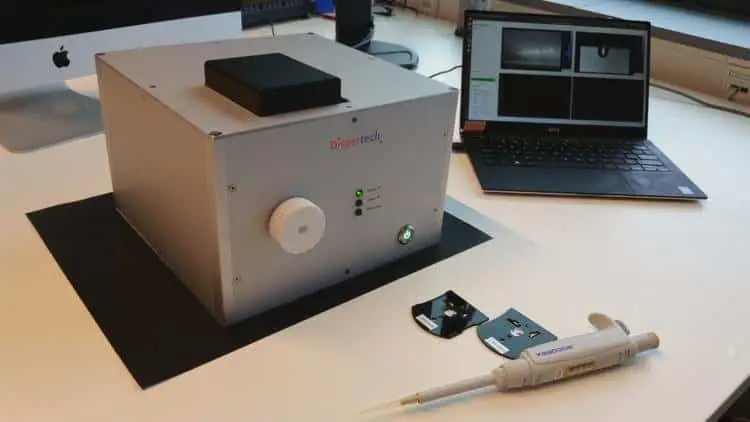Becoming an entrepreneur and a founder was definitely not in my plans when I started my PhD. During my studies I had come across only one professor who was building tools as a small side project, but no one else. Most non-academics with whom I’ve been in contact were working for large, industrial, companies.
When I joined the lab of Michel Orrit in Leiden, I very distinctively remember that in one of the first weeks he put me in contact with a former PhD in chemistry who had started his own company and was selling instruments that could be interesting for my project.
That small action was perhaps the seed of a very lengthy and slow train of thought that led me to where I am today.
My path is definitely not a linear one. I didn’t go from PhD to founder, to successful businessman.
My unfair advantage
My PhD was focused on building new tools to study poorly understood phenomena. I think that gave me a somewhat unfair advantage, because I learned how to make things. One of the early bottlenecks I had to overcome was developing software to control my setup.
Due to a mistake, a technician accidentally formatted the wrong computer in the lab. I was never able to run the original control software again.
That forced me to look deeply into how to solve my own problems, and triggered a complete new line of inquiry.
I was never the best at optics. I have to acknowledge that aligning microscopes requires a lot of patience. It is an iterative process of optimization, that very quickly becomes a painstakingly slow path to a signal in a detector. And all of this happens in a dark room, while days go by outside.
However, by automating my setup, I didn’t need to have a top-notch system. I could do experiments no one else could do simply because they would have taken too long, or the reaction time of the person wouldn’t be quick enough.
That serendipitous formatting of a computer pushed me to explore a more comprehensive approach to doing science.
I learned to build setups and the software to control them. And software is tightly coupled to electronics, so after 4 years of work, I had developed the skills to build complex instruments from the ground up.
The interesting thing of this story is that I didn’t realize what my skills were until much, much later.

My freelancing stunt
Because I was good at developing software for instruments, Sanli Faez, a former colleague (and future business partner), asked me if I could do some things for his lab. He understood that leveraging my knowledge would speed up the time it takes to have things up and running in the lab.
The only condition was that I had to register my own company, since his grants could pay for services but didn’t allow to hire people.
Fortunately, The Netherlands is a country were starting companies and paying taxes is simple enough.
I registered Python for the Lab as a personal business, got my domain name, a logo (a shameful one, but it did its job). Learned how to calculate my hourly rate, and moved into my first consultancy gig.
The software I developed in 2017 is still being used, more than 6 years later, also in other labs.
One thing lead to another, and I started organizing workshops to teach people the skills necessary to develop their own software. I started advising CEOs on how to execute their strategy and mentored a few PhDs who were struggling to build a plan for their careers.
From freelancing to entrepreneur
As much as I liked freelancing, there was a moment when I realized I wanted to grow in other directions.
Freelancing gives you a wealth of problems to solve and allows you to learn very useful skills, but it does not really scale.
At the moment in my life I was in a very unique position: I was outside of academia and I was not pursuing an academic career, I knew how to build things, and I had a bit of an exposure to doing business.
I was still not considering starting something by myself, I was considering joining an existing company, perhaps follow a bit more of a traditional career.
But then Sanli reached out to me again.
For a long time, he had been developing a technique to characterize nano particles. The paper was out, the patent had been granted. He felt like it was time to move it forward but faced a challenge: who would take care of transforming his innovation into a product that could be used by other researchers.
I guess it is clear at this stage what the answer was: me.
Up to that moment, I had never actively considered starting a company. My exposure had been to people building apps, creating websites. The companies I saw emerging in those years, for some reason, felt like something foreign, opportunities that belonged to others.
Getting started
In my experience, and looking at others who have followed the same path, there is nothing harder than getting started. You really have no clue what should be the first thing to do. You are in front of a gigantic blank canvas, trying to build a path for yourself and your ideas.
I joined an incubator (although the details are a source for another story), which helped me engage in some discussions and, more importantly, to slowly get into the mental framework of the entrepreneur.
It became obvious that there was no path forward without money, so that became the number one objective.
With time, the path slowly became clearer, although I never had the chance to formalize it. It is hard when you don’t have access to people a few years ahead of you, who could tell you how the path looked for them.
I spent countless hours studying concepts like ‘the lean startup’ and ‘the business model canvas’. I participated in workshops, discussed with lawyers, accountants, and startup coaches.
It all felt so remote, so un-relatable: what can I learn from studying Uber’s business model? I want to build a microscope!
In the meantime, my personal deadline for finding a source of income was quickly approaching.
As romantic as starting a company can sound, each one of us has a different runway. In my case, I had given myself up to the end of the year to find a relatively stable source of income. I was dangerously approaching my savings limit, the threshold below which I didn’t feel comfortable going if it was not for an emergency.
Creation of Dispertech
By the end of 2018, almost exactly 2 years after I’ve finished my PhD, we had managed to secure a relatively small grant. But that grant had a multiplier effect: it was a pre-condition to convince an investment fund to come onboard and finance the first two years of the company.
In 2019, we established Dispertech. It had several shareholders, a reserve of shares for early employees, a reverse vesting strategy. The whole package: We became a real company.
We partnered with two experienced entrepreneurs who would become the managers of the company, while I would focus on the technical development.
More importantly, I managed to have a salary at the end of each month.

How did I start
During 2019 I was the only employee of the company, which meant that the execution of the plans we had laid down in the business plan were exclusively my responsibility.
The first thing I focused on was transforming the setup we had in the lab into an instrument I could have on a desk.
To be honest, I never thought it was possible to achieve what we achieved.
Transitioning from a well-financed lab, with optical tables, tools, lasers, technicians, to having just a desk, really pushed the boundaries of my creativity. I bought a 3D printer to speed up my own design iterations, learned enough of CAD design to get started.
That was the easy part, because I was on my own. I also had to find suppliers for the components we needed.
Interacting with suppliers can be both fun and stressful. Sometimes you find very cheap alternatives but wonder how well they are going to work. Some suppliers promise to deliver in 2 weeks, while others have a standard delivery time of 2 months or more. Some suppliers feel the urge to give you unsolicited advice on your project. It’s hard to balance how secretive you think you must be, and how open to external help is smart.
In the meantime you realize it is your responsibility to buy everything, from a screw driver to the nail polish you are using as glue.
In parallel to product development, you need to brush up what the incubator said about business development. I started building a massive library of papers from people working in areas I thought would be relevant. Some papers were very explicit regarding the limitations of other techniques.
Desk research only brings you so far. At some point the only valuable thing to do is talking to people.
While discussing with researchers, I understood that techniques claiming to be the holy grail were lagging behind in reproducibility and ease of use. Some others were claiming a resolution that was unrealistic. I knew that if we could tackle some of those challenges, we would have a compelling product.
By the end of 2019, the NanoCET was ready. Some people even liked the design, reminded them of Star Trek the original series.
It took around 8 months to go from registering the company in the chamber of commerce to having a minimum viable product that could be demonstrated with users, brought to conferences, and that would allow us to focus on the key differentiators.
And then what?
With a minimum viable product, a niche market to explore, and lots of energy, it was time to focus on growing the business.
We compiled a list of key opinion leaders to help us gain insights into various fields and their challenges. Moreover, we knew that getting these people onboard with a new technology was crucial to ease the introduction into new research topics. We identified conferences to attend, and started scheduling demos both in person as online.
The story on how to go from funder to manager, however, is a different one.

